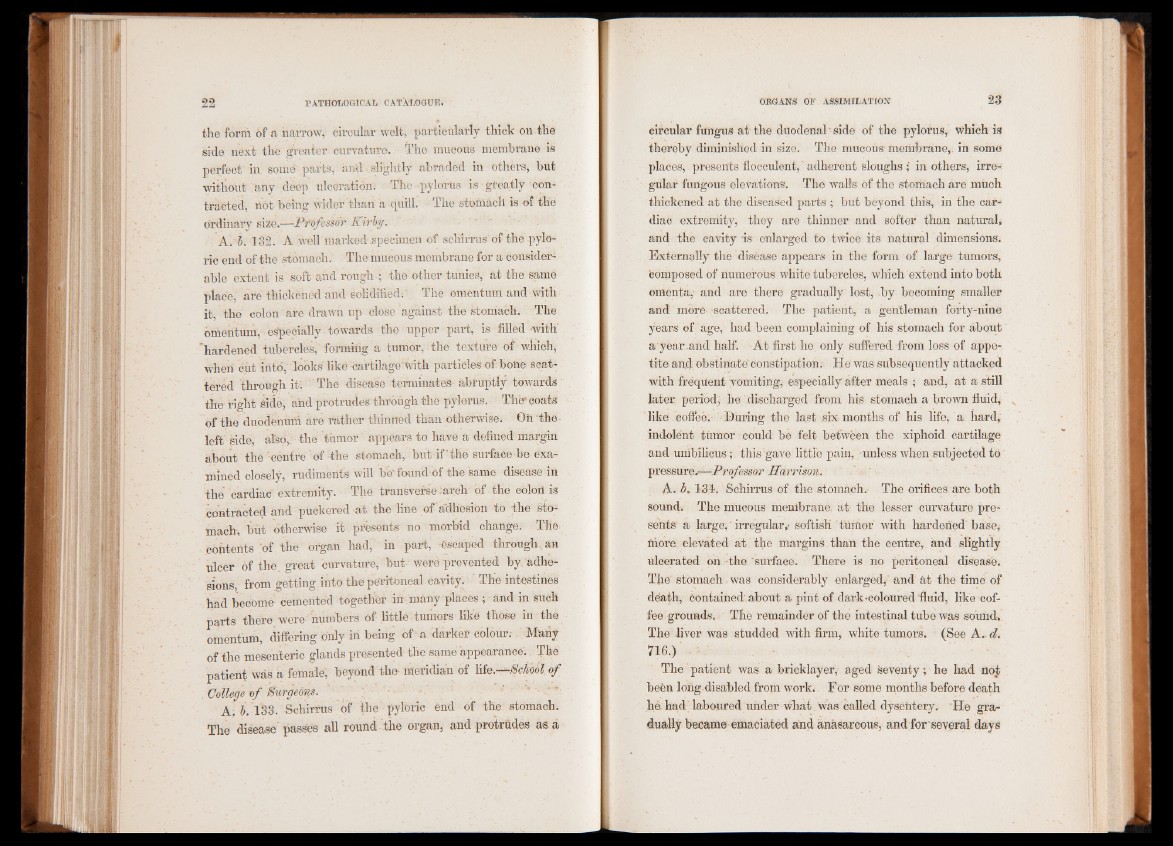
the form öf a .narrow, circular welt, particularly thick on the
side next the greater curvature. The mucous membrane is
perfect'in some parts, and slightly abraded in öthèrs, but
without 'any deep ulceration. The pylorus is greatly contracted,
not being wider than a quill. The stomach is of the
ordinary size.—Professor Kirby.
A b. 132. A well marked specimen of schirrus of the pyloric
end of the stomach. The mucous membrane for a considerable
extent is' soft and rough ; the other tunics, at the same
place; are thickened and solidified. The omentum and with
it, the colon are drawn up close against the stomach. The
omentum, especially towards the upper part, is filled -with
hardened tubercles, forming a tumor, the texture of whichj
when cut into, looks like cartilage with particles of: bone scattered
through it;. The disease terminates- abruptly towards
the right Side, and protrudés through the pylorus. The*coats
of the duodenum are rather thinned than otherwise. On the
left side, also, the tumor ' appears to have a defined margin
about the "centre: of the stomach, but if'thé surface-be examined
closely, rudiments will be found Of the same disease in
the cardiac extremity. The transverse :arch of the colon is
contracted and puckered at the line of adhesion to the stomach,
but otherwise it presents no morbid change. The
contents of the organ had, in part, escaped through, an
ulcer of the. great curvature, but were prevented by adhesions,
from getting into the péritoneal Cavity. The intestines
had become cemented together in many placés ; - and in such
parts there were numbers of little .tumors like those in the
omentum, differing only in being of‘a darker colour. Many
of the mesenteric glands presented the same appearance. The
patient was a female', beyond the- meridian of life.— of
. College of Burgeons.
A. b. 133. Schirrus of the pyloric end of the stomach.
The disease passes all round the organ, and protrudes as à
circular fungus at the duodenal' side of the pylorus, which is
thereby diminished in size. The mucous membrane,, in some
places, presents flocculent,' adherent sloughs ; in others, irregular
fungous elevations. The walls of the stomach are much
thickened at the diseased parts ; but beyond this, in the cardiac
extremit}', they are thinner and softer than natural,
and the cavity is enlarged to twice its natural dimensions.
Externally the disease appears in the form of large tumors,
composed of numerous white tubercles, which extend into both
omenta, and are there gradually lost, by becoming smaller
and more -scattered. The patient, a gentleman forty-nine
years of age, had been complaining of his stomach for about
a year .and half. At first he only suffered from loss of appetite
and obstinate'constipation; He was subsequently attacked
with frequent vomiting, especially after meals ; and, at a still
later period, lie .discharged from his stomach a brown fluid,
like coffee.- During the last six months of his life, a. hard,
indolent tumor could be felt between the xiphoid cartilage
and umbilicus; this'gave little pain,-unless when subjected to
pressure.—Professor Harrison.
A. A 134. Schirrus of the stomach. The orifices are both
sound. The mucous membrane, at- the lesser curvature presents
a large,' irregular,- softish tumor with hardened base,
niore. elevated at the margins , than the centre, and slightly
ulcerated on -the surface. There is no peritoneal disease.
The stomach was considerably enlarged, and at the time of
death, Contained, about a pint of dark-coloured fluid, like coffee
grounds. The remainder of the intestinal tube was sound.
The liver was studded with firm, white tumors. (See A. d.
716.)
The patient was a bricklayer, aged seventy; he load noj;
been long disabled from work. For some months before death
he. had laboured under what Was called dysehtery. He gradually
became emaciated and anasarcous, and for several days